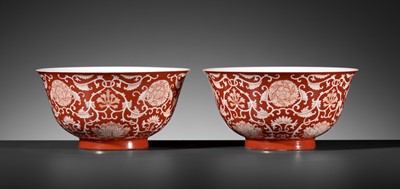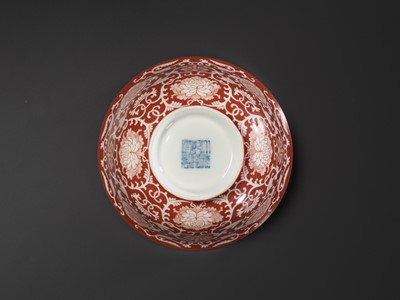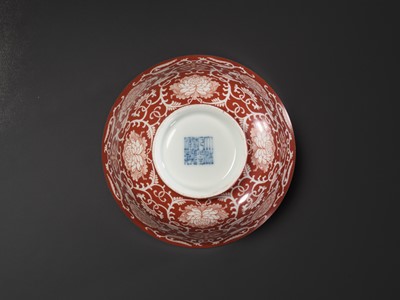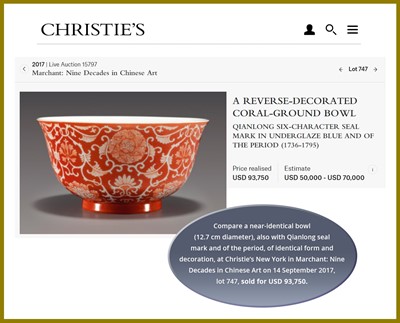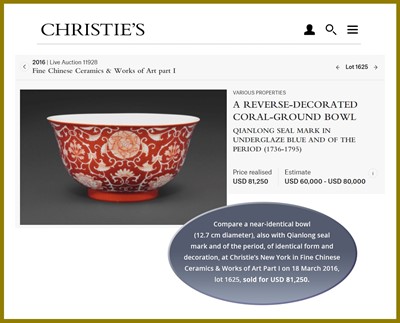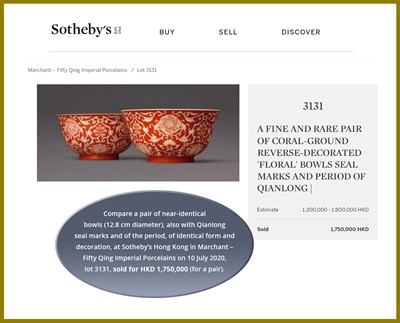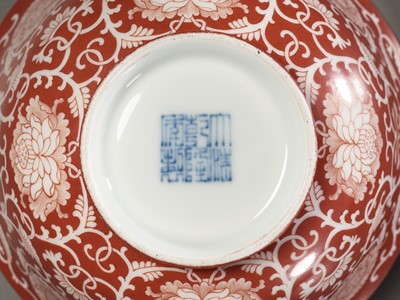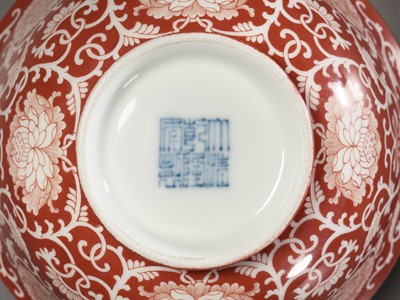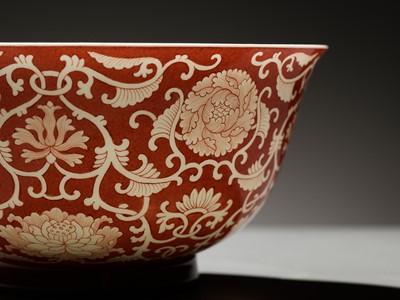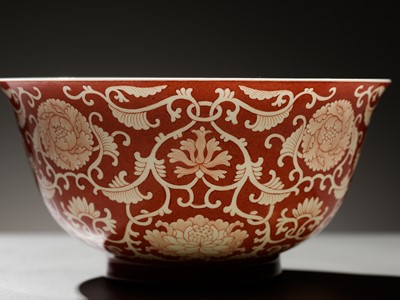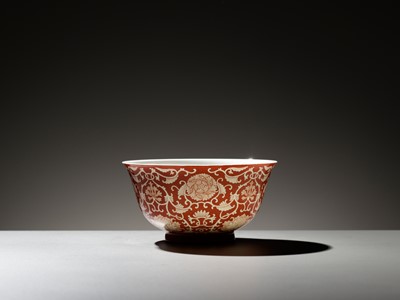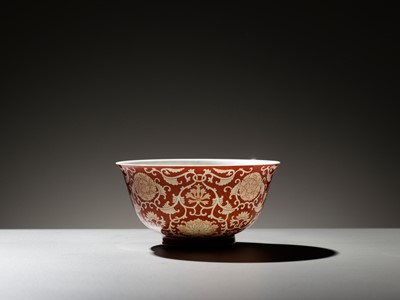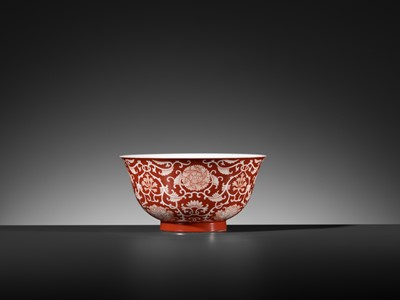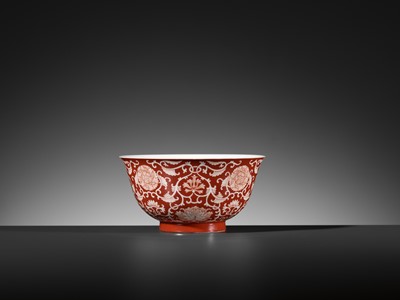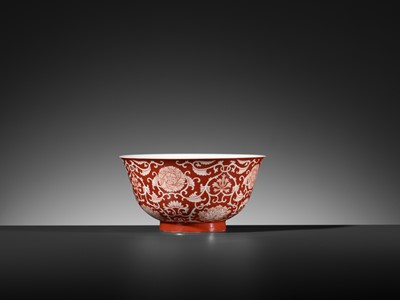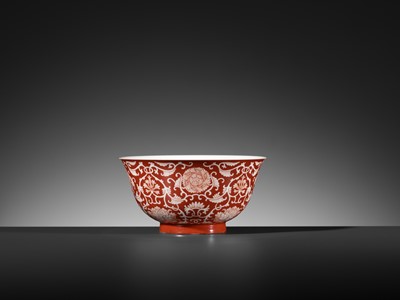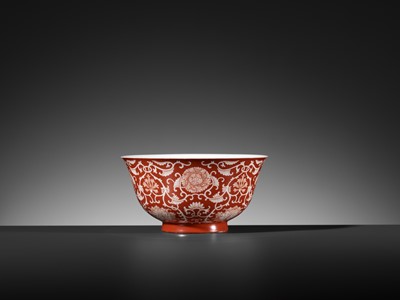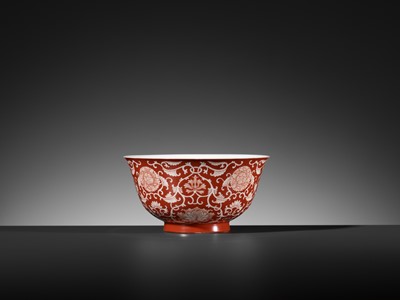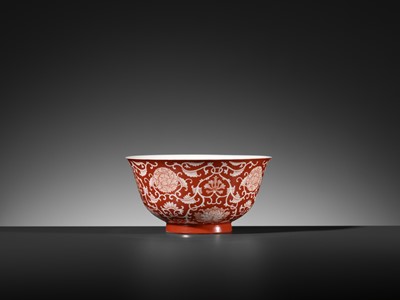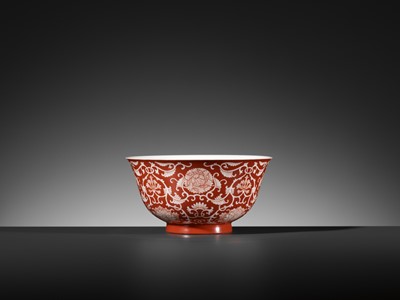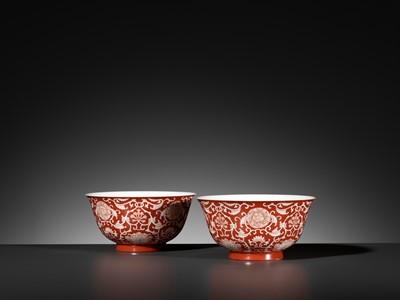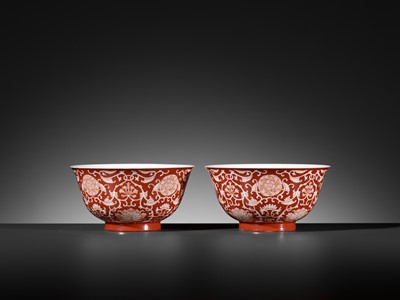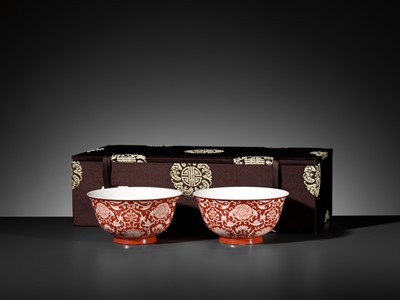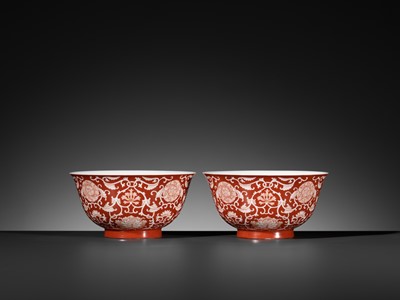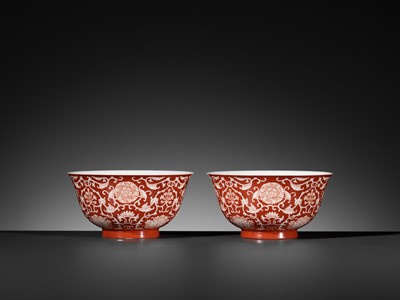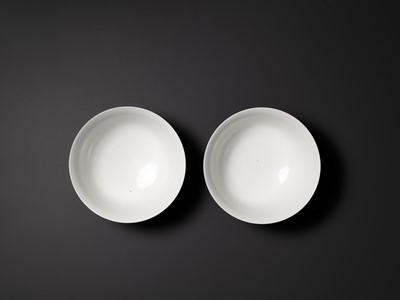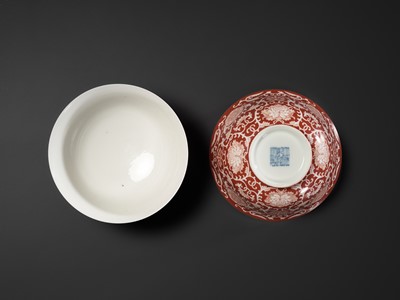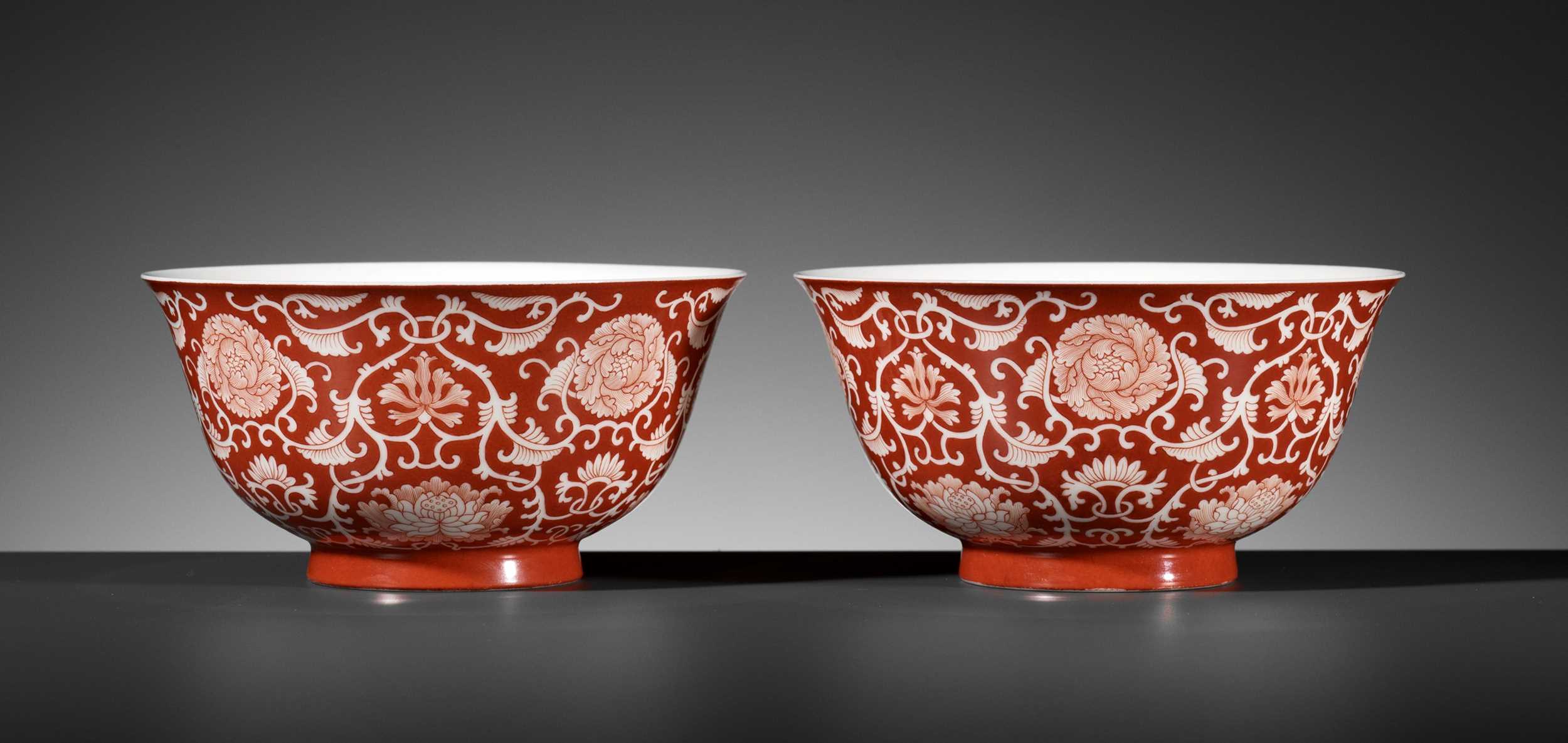11th Mar, 2022 10:00
DAY 2 - TWO-DAY AUCTION - Fine Chinese Art / 中國藝術集珍 / Buddhism & Hinduism
507
A PAIR OF REVERSE-DECORATED CORAL-GROUND ‘PEONY AND LOTUS’ BOWLS, QIANLONG SEAL MARKS AND OF THE PERIOD
乾隆款及年代一對珊瑚紅彩留白纏枝花卉圖碗
Sold for €63,200
including Buyer's Premium
China, 1736-1795. Each delicately and thinly potted, with deep rounded and translucent sides rising from a short, slightly spreading foot to an everted rim. Delicately reverse-decorated in a rich iron-red enamel with a row of peony heads, alternating with smaller lotus above a row of lotus blossoms, all borne on interlocked foliate scrolls reserved in white against the opaque coral ground, the interior left undecorated. The recessed white bases with underglaze-blue six-character seal marks da Qing Qianlong nianzhi and of the period.
Provenance: From a private collection in New York, USA.
Condition: Superb condition with only minor old wear and minimal firing flaws, such as dark spots and minuscule irregularities in the red enamel along the foot. The glaze with a magnificent, unctuous feel overall. In such pristine condition, the present bowls must be considered exceedingly rare.
Weight: 139.2 g and 139.5 g
Dimensions: Diameter 12.9 cm and 13 cm
This exquisite pair of bowls is notable for the meticulously executed floral scroll, which creates a sharp and pleasing contrast against the iron-red ground. While iron red was already used to decorate Cizhou wares in the Jin dynasty (1115-1234), and was adopted at Jingdezhen during the Yuan dynasty, it was only in the 18th century, when all enamels were scrutinized as to their unique properties, that its decorative potential was fully realized. Iron red, which adheres in a thin, opaque layer, allows for razor-sharp lines, which could not be achieved with other enamels that are thicker and glassier. This property makes ‘negative’ reverse designs most successful, giving them a delicacy which can only rarely be seen on ‘positive’ paintings above a white ground. The reverse effect, combined with the unique translucency of the pottery, creates a stunning appearance once sunbeams shine through the bowls.
Porcelain wares decorated with ‘negative’ reverse designs on an iron-red ground are the product of the creative genius of Tang Ying (1682-1756), Superintendent of the Imperial kilns during the Yongzheng and early Qianlong periods. A bondservant of the Plain White Banner, who had served at the court from the age of 16, Tang is credited with the introduction of novel techniques and designs at the kilns. Luxuriant floral scrolls against an iron-red ground first appeared on Yongzheng mark and period boxes, but with additional butterflies, such as one in the Palace Museum, Beijing, illustrated in Kangxi, Yongzheng, Qianlong: Qing Porcelain from the Palace Museum Collection, Hong Kong, 1989, plate 70, and another from the Sir Percival David collection and now in the British Museum, London, published in Margaret Medley, Illustrated Catalogue of Ming Polychrome Wares, London, 1978, plate 163. During the Qianlong period, this reverse-decorated floral design was modified to be used on the outside of bowls, yet without butterflies.
Fitted box. (2)
Literature comparison: A related bowl with Qianlong mark, in the Percival David Foundation, is illustrated in Oriental Ceramics, The World's Great Collections, vol. 6, Tokyo, 1982, pl. 94. Three related bowls, also with Qianlong marks, in the Ohlmer Collection, Roemer Museum, Hildesheim, are illustrated by U. Wiesner, Chinesisches Porzellan, Mainz am Rhein, 1981, no. 130-2. See S. Marchant and Son, Nineteenth Century Mark and Period Porcelain, London, 7-28 June, 1992, no. 28, for a pair of Qianlong mark and period bowls of identical decoration and size.
Auction result comparison: Compare a pair of near-identical bowls (12.8 cm diameter), also with Qianlong seal marks and of the period, of identical form and decoration, at Sotheby’s Hong Kong in Marchant – Fifty Qing Imperial Porcelains on 10 July 2020, lot 3131, sold for HKD 1,750,000 (for a pair). Compare a near-identical bowl (12.7 cm diameter), also with Qianlong seal mark and of the period, of identical form and decoration, at Christie’s New York in Marchant: Nine Decades in Chinese Art on 14 September 2017, lot 747, sold for USD 93,750. Compare a near-identical bowl (12.7 cm diameter), also with Qianlong seal mark and of the period, of identical form and decoration, at Christie’s New York in Fine Chinese Ceramics & Works of Art Part I on 18 March 2016, lot 1625, sold for USD 81,250.
乾隆款及年代一對珊瑚紅彩留白纏枝花卉圖碗
中國,1736-1795年。撇口、深腹、圈足。內壁光素施白釉,外壁珊瑚紅地留白裝飾,纏枝花卉佈局繁密,花紋留白處以珊瑚紅線條勾勒花莖,描繪細緻,格調秀雅。圈足内青花六字款“大清乾隆年製”。
來源:美國紐約私人收藏。
品相:狀況極佳,只有輕微的磨損和燒製瑕疵,例如黑斑和足部紅色琺瑯中的微小不規則性。釉面整體具有華麗晶瑩。如此品相,極爲珍貴。
重量:分別為139.2 克與139.5 克
尺寸:直徑分別爲 12.9 厘米 與13 厘米
這對碗釉色精美,珊瑚紅在金代(1115-1234)已被用於磁州窯器,元代景德鎮也採用了珊瑚紅紅,但直到十八世紀,單色釉的獨特性才被重視並得到充分發展。珊瑚紅在釉上可以產生獨特的效果,在陽光的照耀下,會產生令人驚嘆的效果。
此種珊瑚紅地留白技法始創於清雍正時期,是督陶官唐英(1682-1756)為皇室燒製的專用器。先在白釉上以紅彩勾繪紋飾輪廓,在輪廓外滿填紅彩,形成紅白相應的色彩構圖,是清代獨特的瓷藝品種。此種紋樣創燒自雍正御窯,較之常見的官窯品種更為稀少,彌足珍貴。相應館藏作品請參考北京故宮博物院藏清雍正紅彩地白花蝶蓋盒(參見《故宮珍藏康雍幹瓷器圖錄》,紫禁城出版社、兩木出版社,1989年,頁241,圖70)。另可見倫敦大英博物館Sir Percival David 收藏,見 Margaret Medley, Ming Polychrome Wares, 倫敦1978年,圖163。到了乾隆年代,此紋飾用於碗外壁,並且沒有了蝴蝶。
配套的盒子。(2)
文獻比較:一件相近的同樣有乾隆款的碗,收藏於Percival David Foundation基金會,見Oriental Ceramics, The World's Great Collections, 第6冊,東京 1982年,圖 94。另外三件有乾隆款的碗,收藏於德國 Hildesheim Roemer Museum美術館Ohlmer Collection收藏,見U. Wiesner, Chinesisches Porzellan, Mainz am Rhein, 1981年,圖130-2。見S. Marchant and Son, Nineteenth Century Mark and Period Porcelain, 倫敦,1992年6月7-28日,圖 28, 一對乾隆款及年代的碗,相同紋飾與尺寸。
拍賣結果比較:比較一對幾乎一模一樣的碗 (直徑12.8 厘米),乾隆款及年代,相同形狀與紋飾,見香港蘇富比Marchant – Fifty Qing Imperial Porcelains 2020年7月10日 lot 3131, 售價HKD 1,750,000 (一對);比較一件幾乎一模一樣的碗(直徑12.7 厘米),乾隆款及年代,相同形狀與紋飾,見紐約佳士得Marchant: Nine Decades in Chinese Art 2017年9月14日 lot 747, 售價USD 93,750;比較一件幾乎一樣的碗 (直徑12.7 厘米),乾隆款及年代,相同形狀與紋飾,見紐約佳士得Fine Chinese Ceramics & Works of Art Part I 2016年3月18日 lot 1625, 售價USD 81,250。
China, 1736-1795. Each delicately and thinly potted, with deep rounded and translucent sides rising from a short, slightly spreading foot to an everted rim. Delicately reverse-decorated in a rich iron-red enamel with a row of peony heads, alternating with smaller lotus above a row of lotus blossoms, all borne on interlocked foliate scrolls reserved in white against the opaque coral ground, the interior left undecorated. The recessed white bases with underglaze-blue six-character seal marks da Qing Qianlong nianzhi and of the period.
Provenance: From a private collection in New York, USA.
Condition: Superb condition with only minor old wear and minimal firing flaws, such as dark spots and minuscule irregularities in the red enamel along the foot. The glaze with a magnificent, unctuous feel overall. In such pristine condition, the present bowls must be considered exceedingly rare.
Weight: 139.2 g and 139.5 g
Dimensions: Diameter 12.9 cm and 13 cm
This exquisite pair of bowls is notable for the meticulously executed floral scroll, which creates a sharp and pleasing contrast against the iron-red ground. While iron red was already used to decorate Cizhou wares in the Jin dynasty (1115-1234), and was adopted at Jingdezhen during the Yuan dynasty, it was only in the 18th century, when all enamels were scrutinized as to their unique properties, that its decorative potential was fully realized. Iron red, which adheres in a thin, opaque layer, allows for razor-sharp lines, which could not be achieved with other enamels that are thicker and glassier. This property makes ‘negative’ reverse designs most successful, giving them a delicacy which can only rarely be seen on ‘positive’ paintings above a white ground. The reverse effect, combined with the unique translucency of the pottery, creates a stunning appearance once sunbeams shine through the bowls.
Porcelain wares decorated with ‘negative’ reverse designs on an iron-red ground are the product of the creative genius of Tang Ying (1682-1756), Superintendent of the Imperial kilns during the Yongzheng and early Qianlong periods. A bondservant of the Plain White Banner, who had served at the court from the age of 16, Tang is credited with the introduction of novel techniques and designs at the kilns. Luxuriant floral scrolls against an iron-red ground first appeared on Yongzheng mark and period boxes, but with additional butterflies, such as one in the Palace Museum, Beijing, illustrated in Kangxi, Yongzheng, Qianlong: Qing Porcelain from the Palace Museum Collection, Hong Kong, 1989, plate 70, and another from the Sir Percival David collection and now in the British Museum, London, published in Margaret Medley, Illustrated Catalogue of Ming Polychrome Wares, London, 1978, plate 163. During the Qianlong period, this reverse-decorated floral design was modified to be used on the outside of bowls, yet without butterflies.
Fitted box. (2)
Literature comparison: A related bowl with Qianlong mark, in the Percival David Foundation, is illustrated in Oriental Ceramics, The World's Great Collections, vol. 6, Tokyo, 1982, pl. 94. Three related bowls, also with Qianlong marks, in the Ohlmer Collection, Roemer Museum, Hildesheim, are illustrated by U. Wiesner, Chinesisches Porzellan, Mainz am Rhein, 1981, no. 130-2. See S. Marchant and Son, Nineteenth Century Mark and Period Porcelain, London, 7-28 June, 1992, no. 28, for a pair of Qianlong mark and period bowls of identical decoration and size.
Auction result comparison: Compare a pair of near-identical bowls (12.8 cm diameter), also with Qianlong seal marks and of the period, of identical form and decoration, at Sotheby’s Hong Kong in Marchant – Fifty Qing Imperial Porcelains on 10 July 2020, lot 3131, sold for HKD 1,750,000 (for a pair). Compare a near-identical bowl (12.7 cm diameter), also with Qianlong seal mark and of the period, of identical form and decoration, at Christie’s New York in Marchant: Nine Decades in Chinese Art on 14 September 2017, lot 747, sold for USD 93,750. Compare a near-identical bowl (12.7 cm diameter), also with Qianlong seal mark and of the period, of identical form and decoration, at Christie’s New York in Fine Chinese Ceramics & Works of Art Part I on 18 March 2016, lot 1625, sold for USD 81,250.
乾隆款及年代一對珊瑚紅彩留白纏枝花卉圖碗
中國,1736-1795年。撇口、深腹、圈足。內壁光素施白釉,外壁珊瑚紅地留白裝飾,纏枝花卉佈局繁密,花紋留白處以珊瑚紅線條勾勒花莖,描繪細緻,格調秀雅。圈足内青花六字款“大清乾隆年製”。
來源:美國紐約私人收藏。
品相:狀況極佳,只有輕微的磨損和燒製瑕疵,例如黑斑和足部紅色琺瑯中的微小不規則性。釉面整體具有華麗晶瑩。如此品相,極爲珍貴。
重量:分別為139.2 克與139.5 克
尺寸:直徑分別爲 12.9 厘米 與13 厘米
這對碗釉色精美,珊瑚紅在金代(1115-1234)已被用於磁州窯器,元代景德鎮也採用了珊瑚紅紅,但直到十八世紀,單色釉的獨特性才被重視並得到充分發展。珊瑚紅在釉上可以產生獨特的效果,在陽光的照耀下,會產生令人驚嘆的效果。
此種珊瑚紅地留白技法始創於清雍正時期,是督陶官唐英(1682-1756)為皇室燒製的專用器。先在白釉上以紅彩勾繪紋飾輪廓,在輪廓外滿填紅彩,形成紅白相應的色彩構圖,是清代獨特的瓷藝品種。此種紋樣創燒自雍正御窯,較之常見的官窯品種更為稀少,彌足珍貴。相應館藏作品請參考北京故宮博物院藏清雍正紅彩地白花蝶蓋盒(參見《故宮珍藏康雍幹瓷器圖錄》,紫禁城出版社、兩木出版社,1989年,頁241,圖70)。另可見倫敦大英博物館Sir Percival David 收藏,見 Margaret Medley, Ming Polychrome Wares, 倫敦1978年,圖163。到了乾隆年代,此紋飾用於碗外壁,並且沒有了蝴蝶。
配套的盒子。(2)
文獻比較:一件相近的同樣有乾隆款的碗,收藏於Percival David Foundation基金會,見Oriental Ceramics, The World's Great Collections, 第6冊,東京 1982年,圖 94。另外三件有乾隆款的碗,收藏於德國 Hildesheim Roemer Museum美術館Ohlmer Collection收藏,見U. Wiesner, Chinesisches Porzellan, Mainz am Rhein, 1981年,圖130-2。見S. Marchant and Son, Nineteenth Century Mark and Period Porcelain, 倫敦,1992年6月7-28日,圖 28, 一對乾隆款及年代的碗,相同紋飾與尺寸。
拍賣結果比較:比較一對幾乎一模一樣的碗 (直徑12.8 厘米),乾隆款及年代,相同形狀與紋飾,見香港蘇富比Marchant – Fifty Qing Imperial Porcelains 2020年7月10日 lot 3131, 售價HKD 1,750,000 (一對);比較一件幾乎一模一樣的碗(直徑12.7 厘米),乾隆款及年代,相同形狀與紋飾,見紐約佳士得Marchant: Nine Decades in Chinese Art 2017年9月14日 lot 747, 售價USD 93,750;比較一件幾乎一樣的碗 (直徑12.7 厘米),乾隆款及年代,相同形狀與紋飾,見紐約佳士得Fine Chinese Ceramics & Works of Art Part I 2016年3月18日 lot 1625, 售價USD 81,250。
Zacke Live Online Bidding
Our online bidding platform makes it easier than ever to bid in our auctions! When you bid through our website, you can take advantage of our premium buyer's terms without incurring any additional online bidding surcharges.
To bid live online, you'll need to create an online account. Once your account is created and your identity is verified, you can register to bid in an auction up to 12 hours before the auction begins.
Intended Spend and Bid Limits
When you register to bid in an online auction, you will need to share your intended maximum spending budget for the auction. We will then review your intended spend and set a bid limit for you. Once you have pre-registered for a live online auction, you can see your intended spend and bid limit by going to 'Account Settings' and clicking on 'Live Bidding Registrations'.
Your bid limit will be the maximum amount you can bid during the auction. Your bid limit is for the hammer price and is not affected by the buyer’s premium and VAT. For example, if you have a bid limit of €1,000 and place two winning bids for €300 and €200, then you will only be able to bid €500 for the rest of the auction. If you try to place a bid that is higher than €500, you will not be able to do so.
Online Absentee and Telephone Bids
You can now leave absentee and telephone bids on our website!
Absentee Bidding
Once you've created an account and your identity is verified, you can leave your absentee bid directly on the lot page. We will contact you when your bids have been confirmed.
Telephone Bidding
Once you've created an account and your identity is verified, you can leave telephone bids online. We will contact you when your bids have been confirmed.
Classic Absentee and Telephone Bidding Form
You can still submit absentee and telephone bids by email or fax if you prefer. Simply fill out the Absentee Bidding/Telephone bidding form and return it to us by email at office@zacke.at or by fax at +43 (1) 532 04 52 20. You can download the PDF from our Upcoming Auctions page.
How-To Guides
How to Create Your Personal Zacke Account
How to Register to Bid on Zacke Live
How to Leave Absentee Bids Online
How to Leave Telephone Bids Online
中文版本的操作指南
创建新账号
注册Zacke Live在线直播竞拍(免平台费)
缺席投标和电话投标
Third-Party Bidding
We partner with best-in-class third-party partners to make it easy for you to bid online in the channel of your choice. Please note that if you bid with one of our third-party online partners, then there will be a live bidding surcharge on top of your final purchase price. You can find all of our fees here. Here's a full list of our third-party partners:
- 51 Bid Live
- EpaiLive
- ArtFoxLive
- Invaluable
- LiveAuctioneers
- the-saleroom
- lot-tissimo
- Drouot
Please note that we place different auctions on different platforms. For example, in general, we only place Chinese art auctions on 51 Bid Live.
Bidding in Person
You must register to bid in person and will be assigned a paddle at the auction. Please contact us at office@zacke.at or +43 (1) 532 04 52 for the latest local health and safety guidelines.
